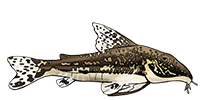| Scientific Name | Glyptothorax lampris Fowler, 1934 |
| Common Name | |
| Type Locality | Chieng Mai, northern Thailand. |
| Pronunciation | Gleep toe thor axe - lam prees |
| Etymology | The generic name comes from the Greek glyptos, meaning carved, and thorax, meaning breastplate (or the part of the body covered by it), in reference to the folds of skin comprising the thoracic adhesive apparatus. From the Greek lampros, meaning brilliant, in reference to the color pattern. |
| Size | 121mm or 4.8" SL. Find near, nearer or same sized spp. |
| Identification | Sisorid catfishes of the genus Glyptothorax Blyth are benthic inhabitants of torrential waters of rivers and streams in montane and submontane parts of tropical Asia. The members of the genus are adapted to attach themselves to rocks and boulders against strong currents by means of a thoracic adhesive apparatus comprising grooves and folded pleats of skin parallel or oblique to the longitudinal axis of the body. The genus has a wide distribution, ranging from Turkey and Syria in the west, to India and China in the east, and extending further southeastward to Indonesia. With 84 nominal species, Glyptothorax are the most speciose genus of catfishes in Asia (Eschmeyer et al., 1998, Ng, 2005); 67 species were treated as valid by Thomson & Page (2006). Greyish brown body with 3 dark brown saddles (under dorsal, adipose and at the caudal base), connected by a dark mid-lateral stripe, leaving pale oval patches. Caudal peduncle slender, depth about 3 times in its length; body and head covered by rough tubercles of very heterogenous size. |
| Distribution | Asia: Mekong and Chao Phraya basins and southeastern Thailand. Mekong (click on these areas to find other species found there) Thailand Waters, Chao Praya (click on these areas to find other species found there) Login to view the map. |
| IUCN Red List Category | Least Concern , range map and more is available on the IUCN species page. Last assessed 2011. |
| pH | 6.0 - 7.0 |
| Temperature | 20.0-24.0°C or 68-75.2°F (Show species within this range) |
| Other Parameters | Strong current preferred. |
| Feeding | Will feed on live/frozen food, but does not appear to take prepared foods. User data. |
| Furniture | A sandy/gravel bottom and enough rocks/driftwood to partially deflect the current and for the fish to hide in. |
| Compatibility | A peaceful species suitable for the hillstream biotope tank. Best kept in a well-oxygenated tank with strong current. Ideal tankmates include balitorine loaches such as Homaloptera, fast-swimming cyprinids such as Danio or Barilius, and smaller mastacembelids. |
| Breeding | Not reported. |
| Breeding Reports | There is no breeding report. |
| Reference | Proceedings of the Academy of Natural Sciences of Philadelphia v. 86, pp 91, Figs. 34-36. |
| Registered Keepers | There is but a single registered keeper, view all "my cats" data. |
| Wishlists | Love this species? Click the heart to add it to your wish list. There is but a single wish to keep this species, see who wants what. |
| Spotters | Spotted this species somewhere? Click the binoculars! There are 4 records of this fish being seen, view them all. |
| Forum BBCode | |
| Search for G. lampris | |
| Look up G. lampris on AquaticRepublic.com | |
 | Look up G. lampris on Fishbase |
 | Look up G. lampris on Encyclopedia of Life |
 | Look up G. lampris on Global Biodiversity Information Facility |
| LFS label creator ARN ref:1.20.170.998 | |
| Last Update | 2025 Jan 02 01:37 (species record created: 2003 May 30 00:00) |





/siluriformes/sisoridae/glyptothorax/lampris/1.jpg)
/siluriformes/sisoridae/glyptothorax/lampris/2.jpg)
/siluriformes/sisoridae/glyptothorax/lampris/3.jpg)
/siluriformes/sisoridae/glyptothorax/lampris/4.jpg)
/siluriformes/sisoridae/glyptothorax/lampris/5.jpg)
/siluriformes/sisoridae/glyptothorax/lampris/6.jpg)
/siluriformes/sisoridae/glyptothorax/lampris/7.jpg)
/siluriformes/sisoridae/glyptothorax/lampris/8.jpg)
/siluriformes/sisoridae/glyptothorax/lampris/9.jpg)
/siluriformes/sisoridae/glyptothorax/lampris/10.jpg)
/siluriformes/sisoridae/glyptothorax/lampris/11.jpg)
/siluriformes/sisoridae/glyptothorax/lampris/12.jpg)
/siluriformes/sisoridae/glyptothorax/lampris/13.jpg)
/siluriformes/sisoridae/glyptothorax/lampris/14.jpg)
/siluriformes/sisoridae/glyptothorax/lampris/15.jpg)
/siluriformes/sisoridae/glyptothorax/lampris/16.jpg)
/siluriformes/sisoridae/glyptothorax/lampris/17.jpg)